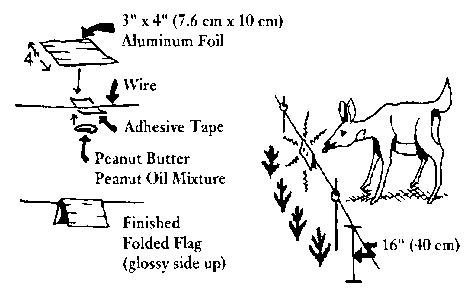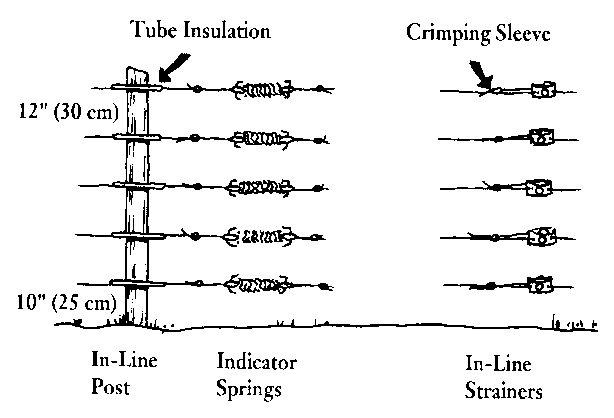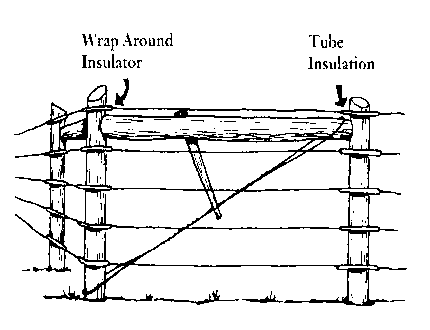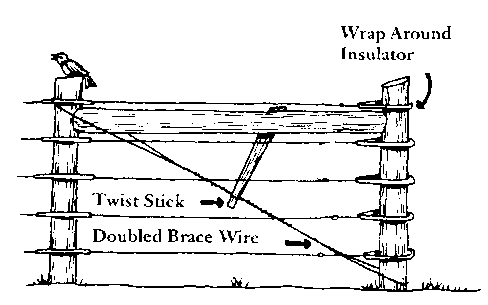
When White-Tailed Deer Become a Nuisance
| By Ross Hall |
The White-tailed deer, Odocoileus virginianus, found in woodland habitats throughout Nova Scotia is often referred to as an animal of edges. They thrive on the borders of farmlands, small cutovers, woodlots, and wetlands. Deer prefer grazing on succulent green plants, but by necessity in winter, browse the twigs of assorted woody vegetation.
Deer have distinctive summer red and winter grey-brown coats. Doe's usually have one or two white-spotted fawns in spring. Bucks grow antlers that are shed each winter.
Severe winters cause hardships for deer. To avoid deep snow and chilly winds, deer move to lower elevations and into mature softwood forests. In spring hungry deer will often damage ornamental shrubs, young orchards, and blueberry vines. In summer they damage home gardens and commercial vegetable crops.
White-tailed deer evoke many emotions. To some people they are a gentle herbivore, perceived to have human values, qualities and behaviors. To hunters they are a challenging quarry. To crop owners they are a source of financial loss and frustration. There is a public reluctance and opposition to killing nuisance deer. Instead peaceful ways are sought to keep deer away from gardens and crops.
Damage Identification
Deer clearly signal their presence by tracks and droppings. Deer do not have front teeth in the upper jaw, so twigs browsed by deer are distinguished from those browsed by snowshoe hare or porcupine by a part bite and jagged tear pattern, rather than a clean cut. It is not unusual to see deer feeding in gardens and crops.
Scare Devices
People have tried many ways to scare deer. Often they do not work, or work only temporarily. They are more practical for home gardens than for larger commercial crops.
An important concept to understand is conditioning. For example, crows become so accustomed to road traffic that they stay at the roadside as traffic speeds by. A scarecrow in a garden will initially make deer nervous, but they will soon overcome any fear. Scare devices must be moved regularly. It helps to use a variety rather than relying too much on one type. Take early action. Once deer have an established habit, they will be more difficult to discourage.
Scare devices can relate to sight, hearing, taste, or smell. There are classic scarecrow structures that resemble human forms. Fertilizer bags inverted over stakes in gardens might bring relief for a week or longer. Try aluminum pie plates, streamers, balloons, and other unusual objects. Use your imagination.
Noise-producing devices might include a radio turned to an all-night station and placed under a protective cover. There are gas exploders, but these may be too expensive and irritating to neighbors for the average garden owner. Deer quickly become accustomed to gas exploders, so they have limited value on large acreage. Shots might be fired to frighten deer. Before shooting, notify the local Natural Resources office and your neighbors, and keep safety in mind.
Repellents
There are various home remedies and trade name repellents that relate to taste or smell. Ground chicken feathers (feather meal), naphthaline (mothballs), creosote, human hair clippings from barber shops, dried blood from slaughterhouses (blood meal), tankage from rendering plants (meat meal) and Magic Circle ™ (bone tar oil) are area repellents applied near the plants to be protected. Contact repellents are sprayed directly on the plants. Hinder ™ (ammonium soaps of higher fatty acids) can be applied to edible crops. Others, such as Big Game Repellant ™ (putrescent whole egg solids) and several products based on the fungicide Thiram are for use on ornamental trees and shrubs and dormant fruit trees. Hot Sauce Animal Repellant ™ (capsaicin) is used similarly to Thiram on dormant growth.
Repellents are not practical for row crops or other large areas. Results of research to test the effectiveness of repellents has not been encouraging. Success is measured in reduction, not elimination of damage. Rainfall will wash away some repellents. In times of food stress, deer are likely to ignore either taste or smell repellents.
Exclusion
The sure way to keep out deer is to build a deer-proof fence at least eight feet (2.4 m) high, ground tight and of woven wire. The high cost is perhaps justified only to keep deer out of very high value or high risk areas such as the runways of major airports. For small gardens, one might improvise with a discarded ground fisherman's net or snow fence. Deer feel insecure inside fences that obstruct visibility. Fences that slant outwards are reported to thwart deer from jumping over them.
Like scare devices, exclusion devices should be used before deer get the habit of feeding in your garden or crop. "An ounce of prevention is worth a pound of cure" is certainly applicable when dealing with nuisance deer.
Electric Fences
There are electric fences designed specifically to exclude deer. They are less expensive than a wire mesh barrier. They require more maintenance, but electric fences do work.
While deer can easily jump over an electric fence, it is normal behavior for a deer to walk to a garden and try to crawl under any barrier. Deer become trained after receiving an initial shock and thereafter stay away from the wires. This also reduces their inclination to jump, since they normally come very close to a barrier before leaping over. A deer has no concept of electricity. Perhaps the deer relate the shock to the more familiar experience of disturbing a hornet's nest.
Electric Fence for Small Gardens
A very simple design that has successfully protected small gardens consists of a single wire suspended about 16 inches (40 cm) above the ground. Face the insulators toward the side from which deer approach. The effectiveness of this type of fence was demonstrated in one example where an apple tree stood beside a garden. Deer ate the apples outside the fence but not inside.
It is very important that the fence deliver a good shock. For good results voltage should be 4000 or higher.

Single Wire Electric Fence
This type of fence might protect larger fields too. Its effectiveness would depend on early implementation, the type of crop, and the use of an energizer that maintains high voltage over longer distances.
The effectiveness of the single-wire fence can be increased by smearing peanut butter on aluminum foil flags taped to the wire. Deer will touch the flags with their tongue or nose. The fence, however, will work without the lure.
Electric Fence With Large Acreages
The second design is meant for commercial agricultural situations. The design, developed in Pennsylvania, is given the name Penn State Vertical Electric Deer Fence¹ .
The fence has five wires. The bottom wire must be approximately 10 inches (25 cm) from the ground, while the remaining wires are spaced at 12 inch (30 cm) intervals above each other, making the fence 58 inches (145 cm) high. Wider spacing is not recommended.
The key materials are: high-tensile smooth steel wire (200,000 psi, 12 ½ gauge), special accessories (indicator springs, in-line wire strainers, crimping sleeves instead of knots, tube insulators, and wrap-around insulators) to maintain 250 lb. (114 kg) wire tension, and high voltage, low impedance energizers.
High-tensile wire absorbs the impact of a deer, falling trees, or branches and farm equipment without stretching or breaking. The tensioned wire and high voltage ensure good shocking power.

Penn State Vertical Electric Deer Fence
The amount of compression of the indicator spring determines when 250 pound (114 kg) tension is reached. Wrap-around insulators used at corner or end posts have galvanized metal inserts that prevent the fence wire from cutting through the insulation under high strain.
Each straight length of fence begins or ends at an end post, corner post, or gate post. These are thicker and longer and are set deeper in the soil than other posts. Construction of brace assemblies at these points is probably the most important aspect of a high-tensile fence because these strong points support the tension on the wires.

Corner Post Construction

End Post Construction
Line posts can be smaller and spaced 50 to 60 feet (15 to 18 m) apart on level terrain where minimal lateral, upward, or downward forces are expected. Removing underbrush and debris along the line, and grading off humps, eliminates many construction problems and results in a fence that is straighter and easier to maintain. An open site about eight feet (2.5 m) should be left outside the perimeter of fences; this ensures that deer will be walking as they approach. Leaving woody fence rows or bushy cover just outside the fence might encourage a deer to jump. In curves or on uneven terrain more posts are needed to maintain the 10 inch (25 cm) bottom wire spacing. The fence must be adequately grounded and have approximately 7.5 yards (7 m) of grounding rod or pipe in the soil. Rather than one long rod, this implies several shorter rod lengths connected by wire. Space ground rods at least 10 feet (3 m). A buried sheet of galvanized roofing also makes an excellent ground.
Electric fences require regular inspection and maintenance. Even with high-voltage, low impedance energizers, weeds growing against the fence must be removed. The weeds, especially if wet, can drain enough voltage to reduce effectiveness.
Fences should also be checked after lightning storms.
The Penn State Vertical Electric Deer Fence is well past the experimental stage and has proven to be an effective deterrent to deer in Nova Scotia and other places. If built properly, it will give good results.
For cost and further technical information contact a farm supply dealer.
Animal Removal
The purpose of this fact sheet is to encourage non-lethal solutions to problem deer, but we should briefly discuss the policy and legal aspects of shooting and killing deer caught destroying gardens and agricultural crops.
A conservation officer may issue a Nuisance Wildlife Permit to kill wildlife if scaring or other methods have been unsuccessful. Any wildlife destroyed must be reported to the Department of Natural Resources and Renewables within 24 hours. Any wildlife remains must be disposed of in a manner that is approved by Department staff.
Lure Crops
By intentionally planting a food source for deer, it is suggested that deer will be attracted away from other crops. A field test of the lure crop idea in Nova Scotia was not effective. The lure crop must be available and more attractive to deer when the other crop is vulnerable. There is extra cultivation cost and the danger of encouraging additional deer to the crop area.
Deer Population
Complaints about nuisance deer increase when deer are plentiful. Part of the solution to deer damage is to keep the deer population in balance with its natural habitat. Discourteous and irresponsible hunters have forced many landowners to put up No Hunting and No Trespassing signs. Landowners with nuisance deer should consider allowing access to responsible hunters.
¹W.L. palmer, J.M. Payne, R.G. Wingard, and J.L. George, 1985 A Practical Fence to Reduce Deer Damage . Wildlife Society Bulletin. 13(3): 240-245
Please contact your local Department of Natural Resources and Renewables office for additional information.